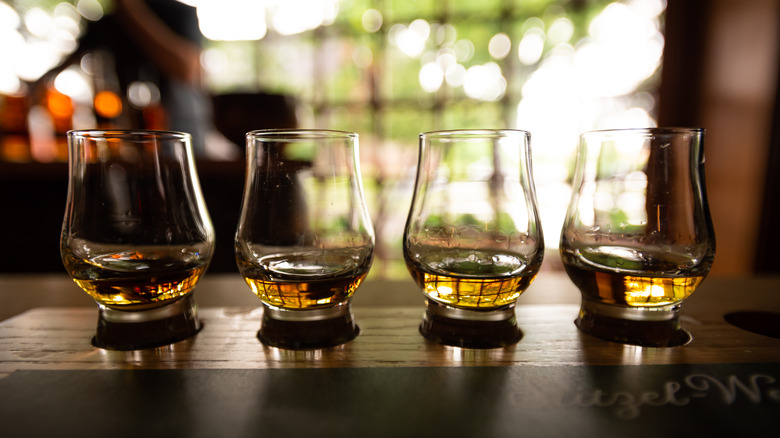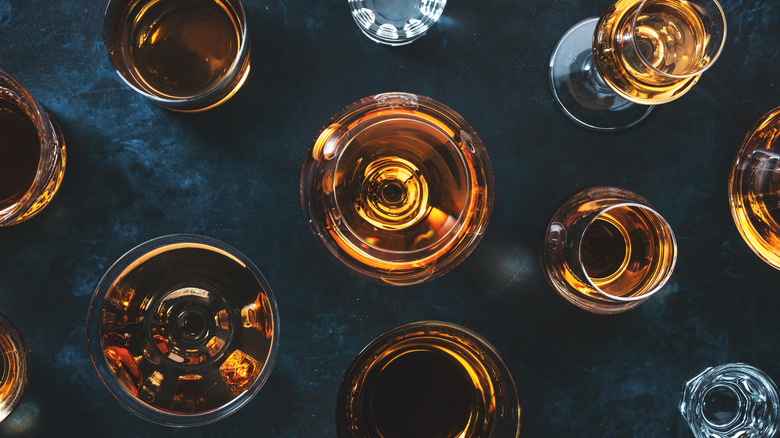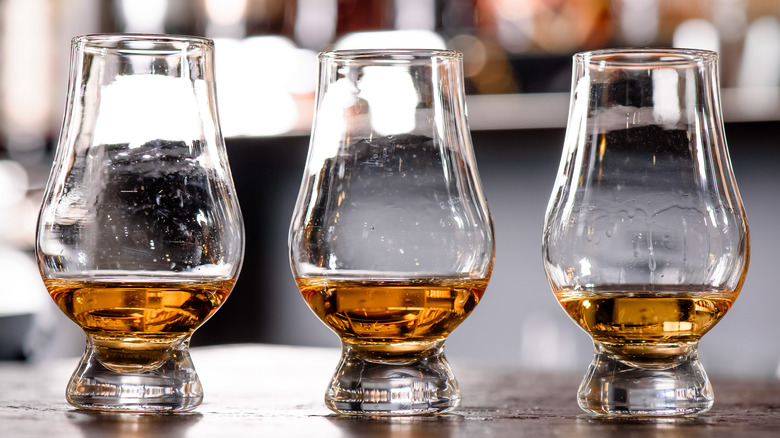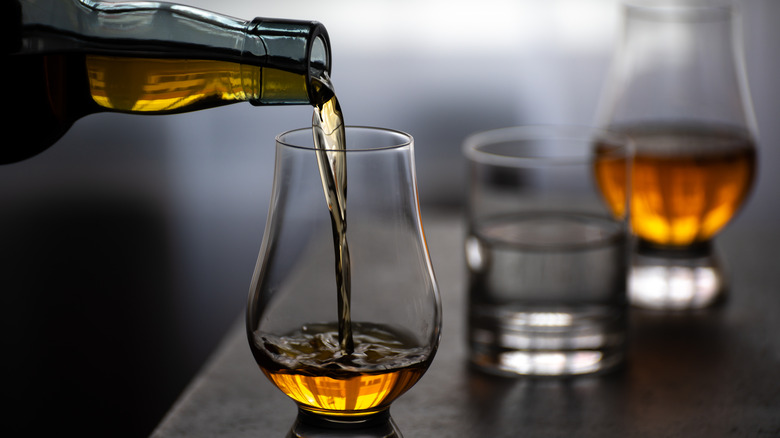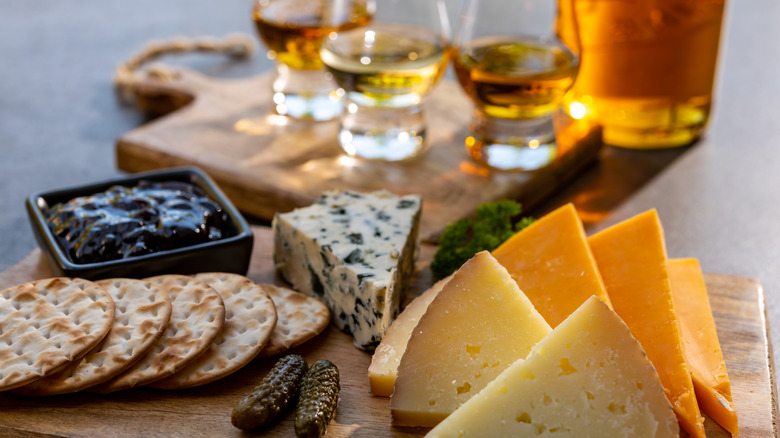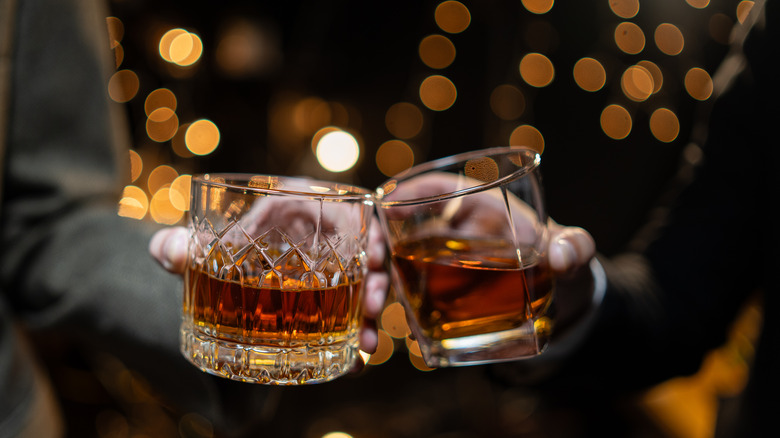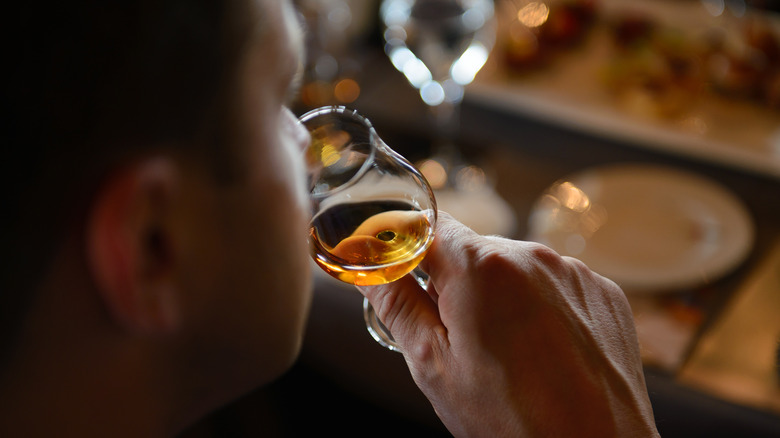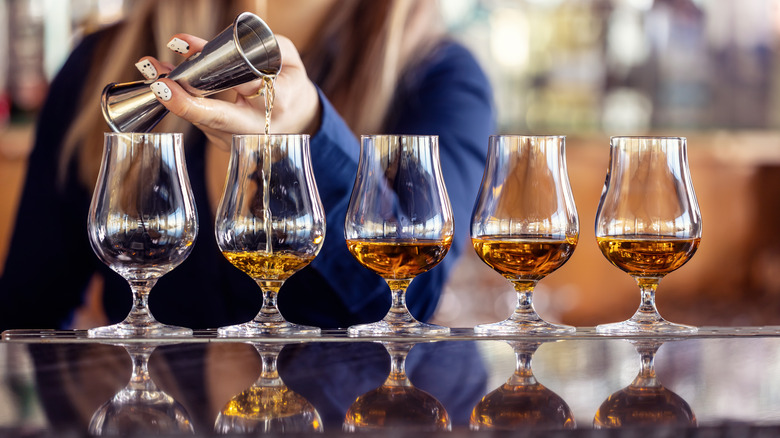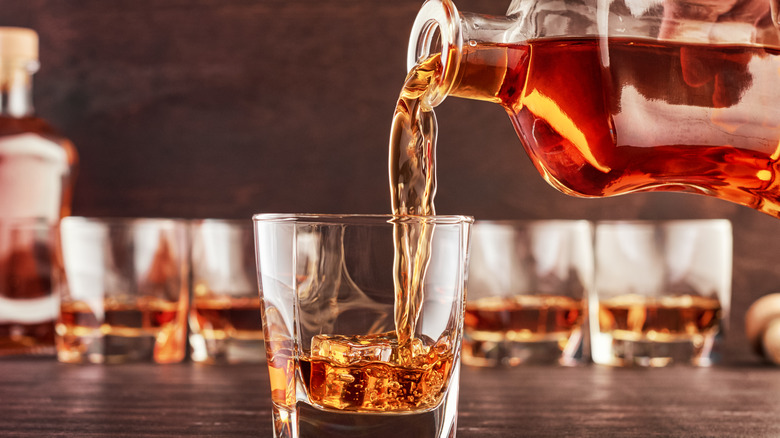12 Tips For Hosting A Bourbon Tasting Party From A Pair Of Whiskey Experts
If you find yourself increasingly interested in the wide world of whiskey, then you've likely looked into the various styles of the spirit. Bourbon is made from primarily distilled corn, which gives it a subtly sweet taste that distinguishes it from other types of whiskey. Sure, you can pick up a couple of bottles and see the nuances of the spirit by yourself, but if you really want to explore the variety available then it's worth hosting a bourbon tasting party.
Before you run to the closest liquor store, pick up a dozen bottles, and call up a group of friends, you might want to slow down and consider logistics. We spoke to Chris Blatner, executive bourbon steward and creator of @urbanbourbonist and Cary Ann Fuller, CSS, executive bourbon steward, and whiskey wanderer behind Straight Up 615, to identify some key tips to hosting a successful tasting party. There is certainly a distinction between a night of drinking and a tasting session, and it's easy to overdo it on the selection and the volume if you're just trying to wing it.
If you're looking for an educational experience to expand your bourbon horizons, then you'll want to follow a few pointers to optimize your experience. From hosting a manageable amount of people and avoiding palate fatigue, to determining how to incorporate food into the experience, there are several things you can do to ensure a smooth bourbon tasting party. Read on to start planning your own.
1. Avoid palate fatigue
Although your first instinct might be to try a wide variety of bourbons at once, after a few sips from several bottles, you'll eventually stop tasting the nuances. Also known as palate fatigue, after trying too many similarly tasting samples, it can become almost impossible to distinguish between them. For that reason, our experts recommend choosing between four to five bourbons for your tasting session.
Chris Blatner notes, "This depends on the experience level of those attending the party," but he still recommends keeping it under six. "This allows for a variety of options and will allow most people to taste without tiring out their palate." If you're working with a roomful of beginners, you might even want to stick to a selection of three, whereas if you're sipping alongside experienced bourbon tasters then you can push it to six.
Apart from the fact that all the bourbons will begin to taste the same, the actual alcohol content can also affect the sensory acuity of your taste buds, making it harder to perceive the unique qualities of the different bourbons. To help decrease some of the effects of palate fatigue, make sure to take your time and sip plenty of water between samples.
2. Pick a theme to streamline the experience
There are plenty of types of bourbon and even more brands producing, so you'll want to narrow down the options to have a cohesive tasting party. Considering the wide assortment, it helps to have a theme in mind in order to home in on a few producers and bottles. It also makes the experience more enjoyable and educational if you can pick a theme and focus on certain qualities that are similar or vary between samples.
Chris Blatner likes choosing a few different styles of bourbon to showcase some variety. This could mean a couple of wheated bourbons, a few with high-rye content, and some high-malt bourbons in order to highlight the nuances in taste. Cary Ann Fuller agrees and shares a few ideas, including tasting bourbons with different mash bills, focusing on a distillery, or sampling a few craft distilleries around the country. Meanwhile, if you've moved on from the basics she suggests: "More advanced lineups could be a vertical selection of yearly releases — like 4 different years of Four Roses Limited Edition Small Batch or Old Forester Birthday bourbon."
Blatner recommends keeping the ABV within a 5% range "to ensure that the comparisons of the whiskey aren't thrown off by the alcohol content varying too much." Fuller is on the same page and prefers to keep proof and age within similar parameters. That said, she points out that either of those components could be compared between bottles from a single distillery.
3. Pay attention to your lineup
For an optimal bourbon tasting experience, it's important to pay attention to how you set up the order of samples. If you try something too bold to begin with, then your palate will be overstimulated and unable to appreciate the subtleties in flavor of milder tasting bourbons. If your lineup features a variety of mash bills, it's best to start with wheated bourbons (made with distilled corn and wheat), move on to more standard bourbons (made with corn and a mix of rye, wheat, or malted barley), and follow up with bolder high-rye bourbons.
Meanwhile, if you're serving a variety of aged bourbons, start with the youngest bottle and make your way to the older one, which will have more complex aromas that are best perceived once your palate has warmed up. If you're serving bottles with a range of alcohol by volume (ABV), make sure to stick to the higher levels later in your tasting to avoid over-stimulating your taste buds from the alcohol right away. Similarly, if any of your bourbons have a smoky profile, be sure to place them at the end of the tasting sequence to prevent them from overwhelming your taste buds.
4. Be mindful about glassware
When you start to get into the world of spirit tasting, it can be easy to splurge on all the accessories to go with the bottles. Even just the glassware can lead to endless purchases. You don't need to go all out when you're hosting a bourbon tasting party, but our experts do recommend being intentional about the glasses you use for the event. Depending on the size and shape of the glass, it will express the aromas in the bourbon differently.
Since the focus of a tasting party is to narrow in on those specific tastes and aromas, Chris Blatner recommends using the same type of glass for all your pours for consistency. He adds, that "ideally there should be a separate glass for each whiskey being tasted." This allows you to go back and forth between bourbons to compare and contrast qualities.
There are many glasses for sipping bourbon that will do the job, and as you explore you'll likely find a favorite. "My preference for glassware is the Libbey Kentucky Bourbon Trail tasting glass," Blatner comments. Meanwhile, Cary Ann Fuller notes, "I use either Glencairn or Kenzie glasses." Indeed, many people think that Glencairn glasses are the best type of glasses for bourbon, due to the curved shape which helps direct the aromas.
5. Don't forget about water
You might think a bourbon tasting party should only include bourbon, but if you skip the water your experience will likely be less successful. Aside from the obvious hydration factor to mitigate the effects of alcohol consumption (even if you're spitting, you'll still be absorbing some alcohol into your bloodstream), there are several reasons to have water on hand.
Chris Blatner notes, "providing plain room temperature water to sip on between tastings will help to clear the palate." One way to slow down the onset of palate fatigue is to properly cleanse your mouth between sips, and water is an easy option. Carry Ann Fuller emphasizes, "Water is probably the most important piece of the tasting — I provide droppers and RO [reverse osmosis] water for both dilution and drinking." Fuller adds, "I always encourage dilution as a way to identify flavors and aromas."
The reasoning goes beyond diluting the alcohol content. Some of the flavor and aroma compounds in the spirit are soluble, and consequently, less easy to perceive on the palate. Once you add a few drops of water, they become insoluble and are more perceptible to tasters. The process involves changes to the ethanol molecules, and as such, it's worth being picky about the type of water you use. Fuller uses reverse osmosis water for its purity, but mainly you'll want to avoid water with a high mineral or contaminant level, which can get in the way of the natural flavors.
6. Think about the role of food
Wine and cheese are a classic pairing, so you might be compelled to add food to your bourbon tasting party. Food is a great asset for any party, but you'll want to consider it carefully if you're introducing it to your spirit tasting session. Our experts have varying thoughts on the matter. Cary Ann Fuller says, "I prefer to have food after a guided tasting." If you're having a laid-back evening with friends, it's a natural addition. However, if your intent is a dedicated educational event, food can get in the way. "The flavors and aromas of the food can mask or alter the flavors of the whiskey if they are not thoughtfully paired," Chris Blatner explains.
According to Blatner, there are two main ways to incorporate food into the experience. The first is to use it as a palate cleanser, much like water. He suggests unsalted almonds or plain crackers as a neutral option to serve between tastings, "... to clear the palate of residual flavors and prepare it for the next whiskey."
On the other hand, he notes you could design your soiree as a whiskey and food tasting event. In this case, he suggests identifying a few flavors in the whiskeys and choosing complementary foods. "For example if a whiskey has chocolate or coffee flavor notes it would be fun to pair that whiskey with various chocolate candies or desserts to enhance the flavor of the whiskey," he suggests.
7. Distinguish between drinking and tasting
Chances are if you're hosting a bourbon tasting party, it's because you like bourbon. Or at the very least you like spirits and are eager to taste more of them. While your alcohol consumption is a personal choice, for the purpose of a tasting party you'll want to stick to tasting versus drinking. While that doesn't mean you have to spit out every sip, it does mean that you're going to do more than just take a shot and move on. The whole point of a tasting party is to identify different flavors and aromas present in your selection of bourbons.
Cary Ann Fuller thinks that overindulgence is one of the prime mistakes when organizing a bourbon tasting party. "It's a tasting, not a shot show! Save the cocktails for after the tasting," she recommends and adds, "Tasting to me includes a lot of dilution and spitting. Otherwise it's just a drinking party with whiskey ... not that there's anything wrong with that!"
8. Make it educational
Your bourbon tasting party doesn't have to feel like you're in a classroom, but it's worth bringing in some educational tidbits to enhance the experience. While your intentions may vary, the goal is to get something out of the tasting session, whether it's identifying aromas that you like or understanding the difference between two styles of bourbon.
For this reason, both of our experts think that including a bit of educational material is a worthwhile addition. Cary Ann Fuller notes, "I like to provide tasting wheels to help people identify what they're tasting." Although you might think you can identify different flavors, when it comes to the same spirit with minor nuances, being able to extract specific aroma compounds can elevate your understanding of each bottle.
Chris Blatner agrees and adds, "Providing information on the source, the mash bill, the age, and price of the whiskey is always interesting and adds to the experience." The more you start to compare differences in mash bill, origin, age, and quality of a bourbon, the more you'll be able to fine-tune your taste. Depending on how deep you want to go, you could prepare a little blurb about the distilleries or different styles of bourbon.
9. Keep it simple to start
Hosting a bourbon tasting party is a lot of fun, but it can become overwhelming if you're trying to do too much. If it's your first time planning this type of event, it might not be the right occasion to invite a dozen people for a food and bourbon tasting night with a lineup of several bourbons. Instead, keep it simple to begin so that you can manage the flow of the tasting session without feeling stressed.
If you're hosting alone, you might want to enlist the help of one of your friends to streamline the evening. For example, they could help set up the glasses and pour the different bourbons, or print out tasting wheels and notes about the different bottles. Additionally, if sourcing all of the bottles is going to require you to go to multiple stores around town, you might want to suggest that your guests each bring a bottle related to a theme.
While you might be tempted to try plenty of different bourbons at once, remember that palate fatigue is a common issue that will ruin your chance of tasting the subtleties between different bottles. Aside from the logistics related to the tasting party, avoid hosting more people than you're comfortable with. Chris Blatner says it best: "whatever you think you can handle in terms of being a host is the best option for you!"
10. Take notes to guide your experience
You might not be in a classroom, but it's still a good idea to take notes at your tasting party. If you have a lineup of four or five bourbons, it's easy to forget what you tasted first by the time you get to the last. If you want to properly examine and compare the different bottles you've chosen, taking notes is the simplest way to keep your thoughts on track. As Chris Blatner suggests, "A tasting sheet with a flavor wheel for people to write down their thoughts and to document what they are tasting is always helpful."
Cary Ann Fuller agrees and recommends providing everyone with a pen and paper to take notes. Whether you let them write their notes freehand or give them some cues or a tasting sheet to fill in is up to you. There are plenty of online sources for bourbon tasting sheets that look at factors such as the nose, palate, and finishing notes, which are associated with the aromas, main flavors, and lingering flavors. This includes sweet, spice, grain, wood, fruit, and floral spectrums of flavor compounds.
11. Be careful not to overpour
Considering the goal is to try a variety of bourbons, it's in your best interest to limit the size of your pours to get through all of your tastings. While alcohol consumption is to an individual's discretion, for the purpose of your party you'll want to measure out the size of each tasting. Aside from the fact that a few sips here and there can quickly add up, depending on how many people you're hosting, you'll want to make sure that everyone can sample the range of bottles.
To make sure you're staying in check, Cary Ann Fuller recommends a quarter or half ounce pour at most if you're tasting a selection of four to five whiskeys. Shot glasses are typically 1.5 ounces, so depending on your selection you're looking at a bit less than two shots. This is especially worth noting if you're pouring higher proof bourbons. These can reach up to 160 proof, which is certainly greater than standard spirits which sit around 80 proof. Consequently, two shots can add up to a far stronger alcohol concentration than you might think depending on what's in your glass.
12. Make sure to keep it fun
Rules and recommendations aside, the goal of your bourbon tasting party should also be to have fun. Unless you're planning to sit for an exam, you don't have to make things overly serious. There are plenty of ways to host a tasting event that is educational, without leaving your guests bored and eager for a post-tasting session cocktail. Your theme can really play into the spirit of the event, and so can involving your guests in the planning stages.
Asking everyone to bring a bottle is a great way to keep the experience enjoyable for all, as people will surely want to share why they opted to bring one bottle over another. You could also plan a blind tasting session to add an element of mystery and guessing to the event. Designing a food and bourbon pairing or having tasty snacks to follow is another way to keep your party in party mode. And while it's definitely a good idea to take notes about what you're tasting and what you've learned, don't force your guests to fill out a page on their tasting if they're enjoying the sensory elements.

